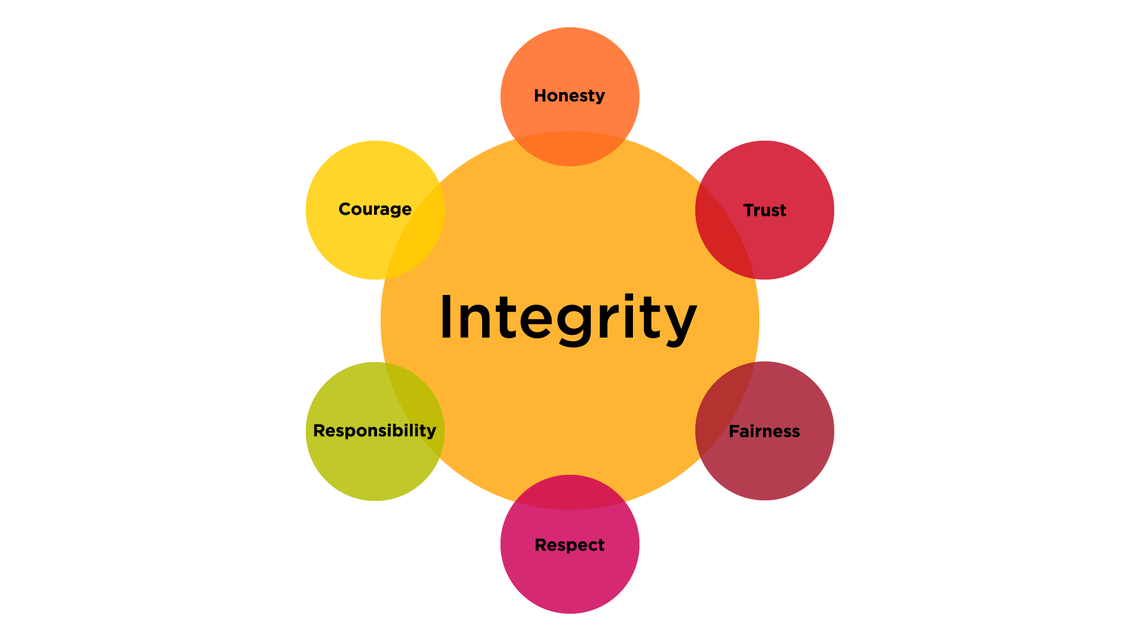
Lesson 6: Academic Integrity in Assessments
Background on academic integrity
In the 1990s, a conceptual shift occurred in higher education from academic misconduct to academic integrity. Integrity is rooted in values, whereas misconduct is focused on behaviour. When learning is centered on integrity, we transform our dialogue with students from how to avoid committing academic misconduct towards how to make ethical decisions — an essential skill students need throughout their professional, academic and personal lives.
Below is the University of Calgary Statement on Academic Integrity:
Academic integrity is the foundation of the development and acquisition of knowledge and is based on values of honesty, trust, responsibility, and respect. We expect members of our community to act with integrity.
Research integrity, ethics, and principles of conduct are key to academic integrity. Members of our campus community are required to abide by our institutional code of conduct and promote academic integrity in upholding the University of Calgary’s reputation of excellence.
6 Fundamental values of integrity

Current Image (ICAI, 2021)
The University of Calgary frames its academic integrity statement on the six fundamental values of integrity; honesty, trust, fairness, respect, responsibility, and courage from the International Center for Academic Integrity (ICAI, 2021). These values form the foundation for ethical learning and ethical assessment practices.
Influencing factors and strategies
There may be intentional or unintentional reasons that lead students to cheat, plagiarize, or engage in other acts of academic misconduct. Below are some influencing factors that may cause students to make poor decisions along with some strategies to mitigate those factors to support our students to make ethical decisions.
Strategies:
- Provide examples of proper academic work, discuss common academic misconduct examples.
- Share links to institutional policies and procedures for further information or student support.
- Explain expectations for open or closed book exams (specifically which resources (if any) are permissible to access during exams)
- Communicate which referencing style(s) is acceptable to use in your course.
- Include an academic integrity FAQ discussion thread in D2L/Brightspace for students to ask questions.
- Provide opportunities for students to submit assignment drafts for feedback.
- Create academic integrity activities (mini-quiz, Q&A, scavenger hunt of our academic integrity policy) that have students engage with each other and you to build a sense of a supportive community.
Strategies
- Discuss your expectations regarding the use of artificial intelligence tools.
- Indicate whether or not artificial intelligence applications are permitted to use in assignments and to what extent.
- Co-create classroom norms related to artificial intelligence use in course assignments.
- Demonstrate an example of an assignment using artificial intelligence and indicate how using artificial intelligence unethically will not meet the criteria for the assignment.
- If you are allowing the use of artificial intelligence apps in your assignments, provide examples of or include resources of how to cite this use properly.
Strategies:
- Provide opportunities for students to learn the technology to reduce their anxiety before a test or project is due, such as a practice quiz that has no grades association.
- Verify that any external learning technology apps that are part of the assessments are free and do not require students to provide personal information
Strategies:
- Communicate expectations early, provide due dates by using the calendar function in D2L/Brightspace, and provide opportunities for timely feedback.
- Talk openly about time management with your students.
- Send reminders about due dates and upcoming quizzes and assignments.
- Encourage students to access academic and student support services and resources.
Strategies
- Design assessments that connect to the course learning outcomes.
- Link classroom activities to assessments (class discussions, lecture material, etc.).
- Create assessments that require students to reflect on their own experience, learning, current events, etc.
- Provide opportunities for students to demonstrate their learning in a variety of formats (essay, presentation, video, infographic, etc.).
- Ensure assignment instructions are specific and not open to interpretation.
Additional references and resources
Bertram Gallant, T. (2017). Academic integrity as a teaching & learning issue: from theory to practice. Theory into Practice, 56(2), 88-94.
Bertram Gallant, T. (2018). Course design, assessment & integrity: strange bedfellows? Retrieved from academicintegrity.org
Camosun College (n.d.). Assessment: Academic integrity. https://camosun.libguides.com/AFL/academic_integrity
"Guidelines for the Use of Artificial Intelligence in University Courses" by Juan David Gutiérrez is licensed under CC BY 4.0
Eaton, S. E., & Christensen Hughes, J. (2022). Academic Integrity in Canada : An Enduring and Essential Challenge. Springer Nature.
Eaton, S. E., Edion, R. I. (2018) “Strengthening the research agenda of educational integrity in Canada: A review of the research and call to action.” International Journal of Educational Integrity, 14(5), 1-21.
Lancaster, T. (2023). Artificial intelligence, text generation tools and ChatGPT – does digital watermarking offer a solution? International Journal for Educational Integrity, 19(1), 1–14. https://doi.org/10.1007/s40979-023-00131-6
Sutton, A., & Taylor, D. (2011). Confusion about collusion: working together and academic integrity. Assessment & Evaluation in Higher Education, 36(7), 831-841.
Velliaris, D.M., & Pierce, J.M. (2019). Cheaters beware! Redesigning assessment practices to reduce academic misconduct. In Velliaris, D.M. (Ed.), Prevention and detection of academic misconduct in higher education (pp. 1- 38). IGI Global.
Lesson checklist
- Develop a deeper understanding of students’ perspectives of academic integrity and the factors that may influence their actions.
- Gain strategies to mitigate the occurrence of academic misconduct in assessments
References
Camosun College (n.d.). Assessment: Academic integrity. https://camosun.libguides.com/AFL/academic_integrity
Eaton, S. E., Edion, R. I. “Strengthening the research agenda of educational integrity in Canada: A review of the research and call to action.” International Journal of Educational Integrity, (2018) 14(5), 1-21.
International Center for Academic Integrity (ICAI). (2021). The fundamental values of academic integrity (3rd ed.). https://academicintegrity.org/resources/fundamental-values
Packalen, K., Rowbotham, K. (2022). Student Insight on Academic Integrity. In: Eaton, S.E., Christensen Hughes, J. (eds) Academic Integrity in Canada. Ethics and Integrity in Educational Contexts, vol 1. Springer, Cham. https://doi.org/10.1007/978-3-030-83255-1_18



